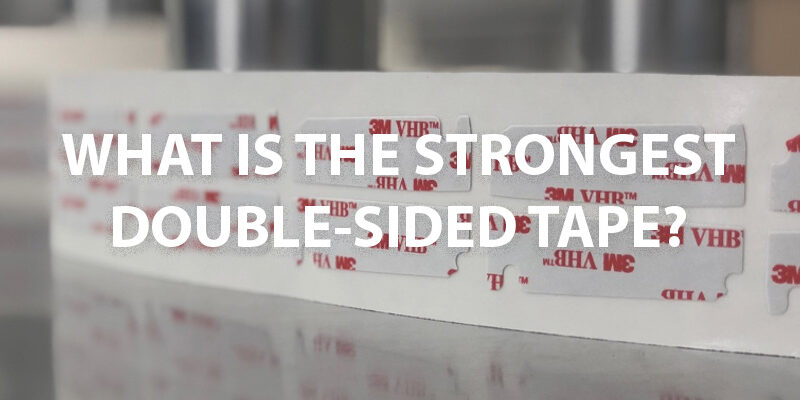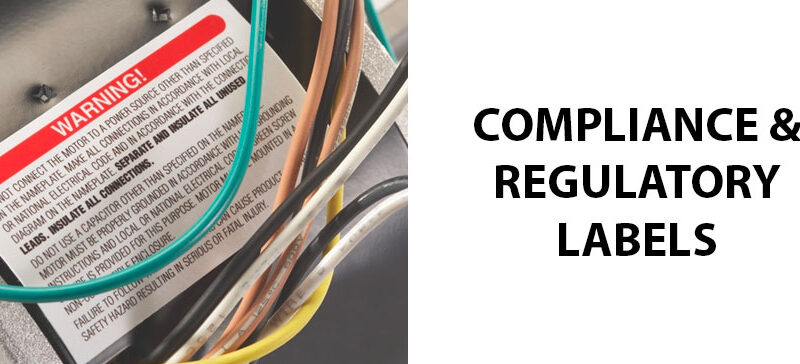Rotary die cutting is a manufacturing process used to cut and shape materials. Using an industrial rotary die-cutting machine, labels and other products can be quickly and precisely cut to shape. A number of industries, like healthcare, automotive, packaging, labeling, and more use this process to create a number of products.
But what exactly is rotary die cutting? How is it different from other methods of die-cutting? And when should you use it? Read on to learn everything you need to know about rotary die cutting.
Direct Thermal vs Thermal Transfer
What Is Rotary Die Cutting?
Rotary die cutting is a label manufacturing method that is versatile, precise, and efficient. A rotary die cutter uses a cylindrical die fitted with sharp blades or creasing lines. The rotary die rotates (hence the name) to cut the labels or other products as the material moves through the machine.
This process is especially useful for custom labels, but can also be used to manufacture a number of products, such as bandages, gaskets, and paper products.
Industrial Rotary Die Cutting Machine
The industrial rotary die-cutting machine is a highly specialized piece of equipment used for rotary die-cutting. These machines are designed for heavy-duty, continuous production. Here are some key features of an industrial rotary die machine:
- Rotary die cylinder: This is an essential component of any rotary die cutter. A rotary die is a cylindrical tool that has sharp blades, creasing lines, or other elements for cutting.
- Anvil cylinder: Another essential component of a rotary die machine is the anvil cylinder. It provides support and pressure so that cuts are clean and precise. The material moves between the rotary die and the anvil during processing. The clearance between the anvil and the rotary die can be adjusted so the right amount of pressure is applied.
- Material handling: Industrial rotary die machines use feeding and tension control systems to make sure the material moves through the machine smoothly. Rolls of material are loaded onto the machine, which then feeds the material through the die-cutting section.
The Rotary Die Cutting Process
Now that you know a little more about rotary die-cutters, let’s walk through the die-cutting process step by step.
- The process starts with a roll of material. The material is unwound and fed into the machine.
- Before production begins, the die has to be configured to match the label’s shape and size. Features like perforations or scores are configured at this point.
- As the material moves through the machine, it passes between the rotary die and anvil roll. The rotary die and anvil both rotate in opposite directions. While the material passes through, the blades of the die make contact with the material, cutting or shaping it.
- Any excess material or waste generated during the process is usually removed at this stage. Many of these machines have vacuum systems or stripping stations that clear away the extra material without the need to stop the process.
- Finally, the finished labels are wound onto another roll or cut into individual sheets, depending on what the client needs.
Types of Rotary Die Cutting Dies
One of the major advantages of rotary die cutting is just how flexible and versatile it can be. Rotary die cutters can cut a variety of materials into custom shapes. The rotary die is the tool that enables this versatility. There are two main types of rotary die cutting dies: solid and flexible. Choosing the right type of rotary die for the job is important, as they each have their own advantages and disadvantages.
- Solid rotary dies: Solid rotary dies are made from a single piece of hardened steel or other durable material. They last for a long time and can be resharpened as needed. Solid rotary dies are expensive, but because they last for so long, they are often worth the investment. However, the process to change out solid rotary dies can be lengthy, causing longer lead times than with flexible dies.
- Flexible rotary dies: Flexible rotary dies are made from a thin metal sheet with cutting lines etched into the surface. A magnetic cylinder holds the metal sheet in place so that it can cut or perforate the material. Flexible rotary dies themselves are very affordable and can be produced relatively quickly. However, the magnetic cylinders that hold them in place can be pricey. You’ll need a different cylinder for each size and circumference, which can get costly. With the initial cost out of the way, flexible rotary dies are inexpensive to replace when they wear out.
Rotary vs Flatbed vs Laser Die Cutting
In addition to rotary die cutting, there are a few other common methods of die cutting: laser die cutting and flatbed cutting. Each method has its own advantages and works better for certain applications. Here’s a comparison of these three cutting techniques:
Rotary Die Cutting: Using cylindrical dies with sharp blades, the rotary die rotates to cut the material. This process is ideal for high-speed, continuous production and can be used on a variety of materials. Rotary die cutting offers customization options but is typically better for simpler shapes. Of the three methods, rotary die cutting is the fastest.
Laser Die Cutting: Laser die cutting uses a focused laser beam to cut or engrave materials. It’s very precise and capable of intricate designs and shapes. Like rotary die cutting, laser die cutting works with a variety of materials. It’s even more customizable than rotary die cutting, as there are no physical dies required to make cuts. However, laser die cutting is much slower than rotary die cutting. Laser die cutting is ideal for prototypes, intricate details, short runs, and materials that are difficult to cut by other methods.
Flatbed Cutting: Flatbed cutting uses a hydraulic press and steel rule dies to cut and shape materials. It works with a variety of materials, especially those that are rigid or thick like foam and corrugated cardboard. Steel rule dies are highly customizable, allowing for a wide variety of shapes and sizes. However, flatbed cutting is slower than rotary die cutting.
The choice between rotary die cutting, laser die cutting, and flatbed cutting depends on your specific needs, including the type of material, the level of customization required, and desired precision. For example, flatbed cutting works better for materials too rigid or thick for a rotary cutter. On the other hand, laser cutters are particularly suited for prototypes and intricate designs.
Rotary Die Cutting Uses
Rotary die cutting is used to manufacture a variety of products across a number of industries. Some common rotary die cutting uses include:
- Packaging: The packaging industry uses rotary die cutting to produce a number of flexible packaging products, such as pouches, sachets, and bags. Additionally, rotary die cutters are used to cut cardboard and corrugated cardboard to create boxes and cartons.
- Labeling: Rotary die cutting is used by many label manufacturers to create custom labels in a variety of shapes and sizes. These might include product labels, barcodes, and security labels.
- Automotive: In the automotive industry, rotary die-cutting machines are used to cut gaskets and seals from foam, rubber, and other materials.
- Medical: The medical sector uses rotary die cutters to manufacture bandages, wound dressings, diagnostic test strips, and adhesive components used for medical devices.
- Stationery: Notepads, sticky notes, file folders, and custom-shaped paper products are all created with rotary die cutting.
- Electronics: This process is used to manufacture components such as EMI/RFI shielding materials, insulators, and protective films for electronic devices.
- Adhesive tapes: From duct tape to masking tape, rotary die cutting is crucial in the production of adhesive tapes.
Capabilities of Rotary Die Cutting
Rotary die cutting is highly versatile with a number of capabilities. It can be used on a wide range of materials, like paper, cardboard, plastics, foils, films, and textiles. Here are some of the capabilities of an industrial rotary die-cutting machine:
- Kiss cutting: Kiss cutting is a technique in die cutting where the die cuts through the top layer of a material without cutting through the backing or liner. This is often used with sheets of labels, stickers, decals, and other adhesive-backed products.
- Metal-to-metal die cutting: Metal-to-metal die cutting is the process of using solid metal rotary dies to cut through multi-layered materials completely.
- Perforation: Perforation involves punching evenly spaced holes or cuts in a material to allow for easy tearing or separation. Perforation is used for tear-off coupons, packaging materials, and products with sections that need to be easily detached.
- Lamination: Lamination is the process of sandwiching one or more layers of material between two layers of protective material. A heated rotary die heats up the laminate to seal the material being protected. Lamination can increase the durability of a product, as well as enhance its aesthetics.
Pros and Cons
Rotary die cutting comes with a lot of benefits, but it also has some disadvantages. Here are some of the pros and cons of die cutting:
Pros:
- High-precision: Rotary die cutting ensures precise and consistent cuts so that labels and products are identical.
- High-speed production: It’s a fast and continuous process that works well for high-volume label manufacturing.
- Versatility: Customization is easy, allowing for a wide range of label shapes, sizes, and designs.
- Cost-effective: It minimizes material wastage, making it cost-efficient for large production runs.
- Clean cuts: Rotary dies produce clean and sharp edges on labels.
Cons:
- Limited complex shapes: Rotary die cutting doesn’t work as well when creating extremely complex shapes or designs, especially those with interior cuts. In these cases, laser cutting may be a better choice.
- Tooling costs: It costs a lot of money to create custom rotary dies, especially solid rotary dies. If you’ll be using the rotary die for high-volume runs, the cost ends up paying for itself, but it isn’t very cost-effective for small runs or products that change a lot.
- Material limitations: Because of how a rotary die functions, it doesn’t work as well for rigid or thick materials. When you need to cut a thick material, flatbed cutting may be more appropriate.
- Setup time: Setting up a rotary die-cutting machine for a new job can be time-consuming, especially when changing dies or adjusting for different materials. However, flexible rotary dies offer much faster setup time than solid rotary dies.
Summary
Rotary die cutting is one of the most efficient, cost-effective ways to cut precise designs in a variety of materials. From healthcare to packaging, a number of industries utilize this process to shape their products. Rotary die cutting comes with a number of benefits (like high precision and versatility), but it’s limited in certain areas (like the tooling costs and setup time).
At Coast Label, our primary method of cutting labels is our industrial rotary die-cutting machine. We also use a semi-rotary machine as well as a plotter cutter in certain cases. However, the rotary die cutter is our number one method because it allows us to manufacture custom labels quickly and precisely to ensure our customers get the best product.
If you need custom labels, Coast Label has you covered. Whether you’re looking for a high-volume run of barcode labels or weatherproof labels that will stand the test of time, Coast Label will help you find the right solutions for the unique needs of your business.



